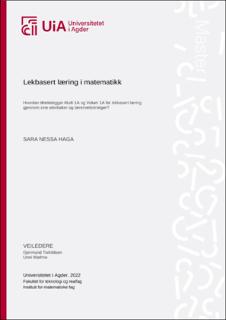| dc.description.abstract | I dette masterprosjektet har det blitt gjennomført lærebokanalyser av to norske matematikklærebøker for 1. trinn med søkelys på deres tilrettelegging for lekbasert læring. Målet med oppgaven er å finne ut: «Hvordan tilrettelegger Multi 1A og Volum 1A for lekbasert læring gjennom sine elevbøker og lærerveiledninger?».
Et rammeverk av Charalambous et al. (2010) har blitt brukt som utgangspunkt for produksjon av mitt eget rammeverk. Analysen deles i to hoveddeler: en horisontal del og en vertikal del. I den horisontale analysen gjøres det en oversiktsanalyse av lærebøkene som helhet, mens i den vertikale analysen gjøres det en dybdeanalyse av utvalgte områder. Det ble utformet to forskningsspørsmål for å utdype problemstillingen. Første forskningsspørsmål besvares i hovedsak gjennom den horisontale analysen, mens det andre forskningsspørsmålet besvares gjennom den vertikale analysedelen.
Det første forskningsspørsmålet omhandler ulike oppgavetypers potensial for lekbasert læring. Her viste det seg at flere oppgavetyper har potensial for lekbasert læring, men at det i stor grad er oppgavetypen «aktivitet og spill» som blir utnyttet i Multi 1A og Volum 1A. Det andre forskningsspørsmålet satte søkelys på karakteristikken til de lekbaserte oppgavene. I Multi 1A og Volum 1A kom det frem at det var mye bruk av regellek og lærerstyrt lek.
Denne studien kan gi relevante innsyn i hvordan Multi 1A og Volum 1A legger til rette for lekbasert læring. Den kan også være en hjelp ved utvelgelse av matematikklæreverk på barneskoler.
Nøkkelord: lek, lekbasert læring, matematikk, begynneropplæring i matematikk.
Engelsk:
This master thesis analyses two Norwegian 1st grade mathematics textbooks, with focus on their facilitation of play-based learning. The purpose of this thesis is to find out: “How does Multi 1A and Volum 1A facilitate play-based learning through their student books and teacher guides?”
A framework by Charalambous et al. (2010) has been used as a starting point to produce my own framework. The analysis is divided into two main parts: a horizontal part and a vertical part. In the horizontal analysis, an overview analysis is made of the textbooks as a whole, while in the vertical analysis, an in-depth analysis of selected areas is analysed. Two research questions were designed to develop the thesis. The first research question is answered mainly through the horizontal analysis, while the second research question is answered through the vertical analysis part.
The first research question deals with the potential of different types of tasks for play-based learning. Here it turned out that several task types have potential for play-based learning, but that it is largely the task type “activity and games” that are utilized in Multi 1A and Volum 1A. The second research question shed light on the characteristics of the play-based tasks. In Multi 1A and Volum 1A, there was a lot of use of games and teacher-led play.
This study can provide relevant insight into how Multi 1A and Volum 1A facilitate play-based learning. It can also be a help in selecting mathematics teaching materials in primary schools.
Keywords: play, play-based learning, mathematics, early mathematics learning | |
